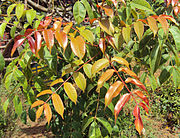Contents
Spondias pinnata, sometimes also known as hog plum, is a species of tree with edible sour fruits. It is native to the Philippines and Indonesia, but has been widely naturalized in South Asia, Mainland Southeast Asia, Southern China, and the Solomon Islands.[2][3] It belongs to the family Anacardiaceae.[4][5][6] This species, among several others, has sometimes called the "wild (or forest) mango" in other languages and was once placed in the genus Mangifera. It is found in lowlands and hill forests up to 1,200 m (3,900 ft).[2]
Description
Spondias pinnata is a deciduous tree, 10–15 metres (33–49 ft) tall (sometimes up to 25 metres (82 ft) in height); branchlets yellowish brown and glabrous.[2] The leaves are large, with pairs of leaflets (see illustration) on petioles that are 100–150 millimetres (3.9–5.9 in) and glabrous; leaf blades 300–400 millimetres (12–16 in), imparipinnately compound with 5-11 opposite leaflets; leaflet petiolule 3–5 millimetres (0.12–0.20 in); leaflet blade ovate-oblong to elliptic-oblong, 70–120 millimetres (2.8–4.7 in) × 40–50 millimetres (1.6–2.0 in), papery, glabrous on both sides, with margins that are serrate or entire; the apex is acuminate, lateral veins 12-25 pairs.
The inflorescence is paniculate, terminal, 250–350 millimetres (9.8–13.8 in) and glabrous, with basal first order branches 100–150 millimetres (3.9–5.9 in). The flowers are mostly sessile and small, white and glabrous; calyx lobes are triangular, approx. 0.5 millimetres (0.020 in). Petals are ovate-oblong, approximately 2.5 by 1.5 millimetres (0.098 in × 0.059 in); stamens are approximately 1.5 millimetres (0.059 in).
The fruit is a drupe ellipsoid to elliptic-ovoid, olive green becoming yellowish orange at maturity, 35–50 millimetres (1.4–2.0 in) × 25–35 millimetres (0.98–1.38 in); inner part of endocarp woody and grooved, outer part fibrous; mature fruit usually have 2 or 3 seeds. In China, it flowers from April–June and fruits from August–September.[2]
Vernacular names
Spondias pinnata may be called in:
- Burmese: ဝှေး (hwei or gwei)
- Chinese: 槟榔青, bing lang qing[2]
- Tagalog: ᜎᜒᜊᜐ᜔, romanized: libas[3]
- Khmer /pɷːn siː pʰlaɛ/ (ពោនស៊ីផ្លែ) or /məkaʔ prẹj/ (ម្កាក់ព្រៃ),[7]
- Javanese (and Malay, Sundanese): kedondong (also for Spondias dulcis), kloncing[8]
- Balinese: kecemcem
- Kannada: Amate Kaai
- Tamil: Pulicha kaai (meaning "sour fruit"); in Sri Lanka it is also called Amberella[citation needed], although this more commonly refers to Spondias dulcis
- Thai: มะกอก, Makok (eponym of the Thai capital Bangkok[9][10])
- Tulu and Konkani: Ambade
- Vietnamese: Cóc rừng ('forest [mango-type fruit]')
- Assamese language: Amora
- Malayalam: Ambhazham
- Bengali: আমড়া (Amra)
- Odia: Ambda
- Lhotshamkha (Bhutan): Amara
- Nepali language: Lapsi
Uses
The fruits have a sour taste and can be eaten raw or made into jams, jellies, or juices. They can also be used as feed for pigs (hence the common name "hog plum").[3]
In the Philippines, libas leaves and fruits are used as a souring agent in various native dishes like sinigang, sinanglay, or laing.[3]
In India, ambda pickle is made using quartered ambda fruits preserved in mustard oil, salt, and spices. Along with mango and chili pepper pickle, it is the most common type of pickle found in households in many parts of India.
Gallery
Spondias pinnata specimens from Kerala, India:
See also
- Spondias purpurea (jocote), similar species from the Americas
- Spondias dulcis, similar species native to Melanesia and Polynesia
References
- ^ Suppl. Pl. 156. 1782
- ^ a b c d e "Spondias pinnata". Flora of China. 11: 339. Retrieved 8 March 2017.
- ^ a b c d Florido, Helen B.; Cortiguerra, Fe F. (2003). "Lesser Known Edible Tree Species" (PDF). Research Information Series on Ecosystems. 15 (3).
- ^ Kurz, 1875 In: Prelim. Rep. For. et Veg. Pegu. Append. A. 44, app. B. 42
- ^ Roskov Y.; Kunze T.; Orrell T.; Abucay L.; Paglinawan L.; Culham A.; Bailly N.; Kirk P.; Bourgoin T.; Baillargeon G.; Decock W.; De Wever A. (2014). Didžiulis V. (ed.). "Species 2000 & ITIS Catalogue of Life: 2014 Annual Checklist". Species 2000: Reading, UK. Retrieved 26 May 2014.
- ^ World Plants: Synonymic Checklists of the Vascular Plants of the World
- ^ LETI, Mathieu, HUL Sovanmoly, Jean-Gabriel FOUCHÉ, CHENG Sun Kaing, Bruno DAVID, Flore photographique du Cambodge, Paris: Privat, 2013, p. 63.
- ^ Heyne, Karel (1913). De nuttige planten van Nederlandsch-Indië (in Dutch). Buitenzorg: Museum voor Economische Botanie. pp. 135–6.
- ^ Klaus Wenk (1968). The restoration of Thailand under Rama I, 1782–1809. Association for Asian Studies/University of Arizona Press. p. 18.
- ^ William Warren (2002). Bangkok. Reaktion Books. p. 13.





